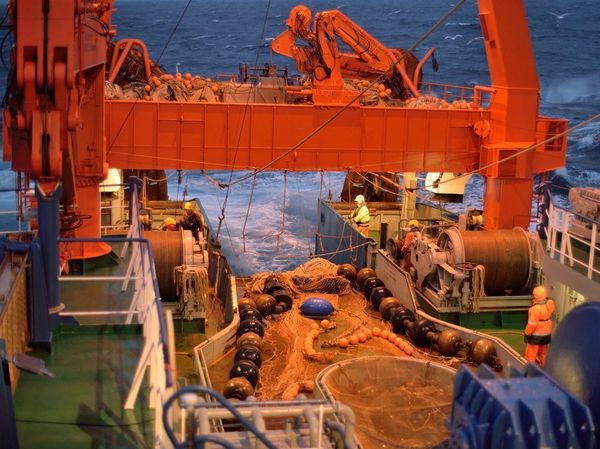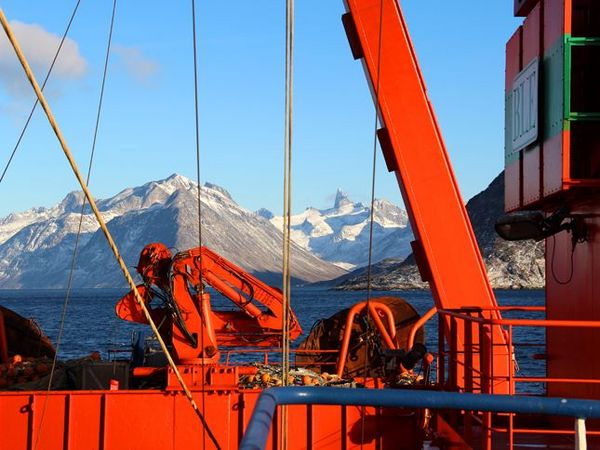Press Release
The deep sea in rhythm with climate change
An international team of experts under the lead of Margrete Emblemsvåg from Møreforsking AS and the Arctic University of Norway and Dr. Karl-Michael Werner from the Thünen Institute of Sea Fisheries in Germany discovered an unexpected connection between bottom fish and the impacts of climate change in East Greenland. While the researchers analysed large time-series of data they observed that ecosystems across the entire depth range from 150-1500 m responded synchronously to changes in the atmosphere, sea ice concentration and sea surface temperature – surprisingly these changes were most visible in deep sea fish, which live below 400 meters. The study is recently released in the journal “Global Change Biology”.
Researchers from the Thünen Institute of Sea Fisheries and the Greenland Institute of Natural Resources collected data on changes in fish communities in depth layers from 150-1500 meters for almost 20 years, from 1998-2016. Every year, they went back to similar spots off East Greenland to sample the fish community using a scientific bottom trawl net, resulting in a sample size of data collected at almost 1400 stations.
“During the analysis of the fish abundance data, we realized that the changes were considerably stronger at depths between 350 and 1000 meters than in shallower regions. When it was statistically verified that these observations in the deep correlated with changes in the atmosphere, the biggest challenge was to develop hypotheses, how these things are connected”, says Margrete Emblemsvåg.
Ecological changes in the deep
The researchers used a statistical method called “tensor decomposition analysis” for their data analysis, which allowed them to analyse changes in fish abundances in time and space simultaneously. “Using this method does not have a long tradition in ecology, but has recently been recognized for its applicability in understanding spatio-temporal dynamics in multi-species fish communities”, says Karl-Michael Werner from the Thünen Institute. “One of the most striking results was that large changes occurred in much greater depths than expected.” Even in regions deeper than 400 meters the researchers observed that boreal warm-water adapted species, such as tusk (Brosme brosme) or blue ling (Molva dypterygia), increased in abundance, while Arctic and sub-Arctic species, such as Greenland halibut (Reinhardtius hippoglossoides) or Northern wolffish (Anarhichas denticulatus) declined.
Transitional change and extreme events
The outputs from tensor decomposition displayed a rapid change in abundances of fish communities in great depths in the years between 2005 and 2010. Simultaneously, atmospheric temperature, sea surface temperature and sea surface salinity rose, while the extent of sea ice declined during these years. The results also showed short-term responses of deep-sea fish communities synchronous to annual environmental variability and extreme years such as 2003, when sea surface temperatures were exceptionally high. Fish communities in the deep sea might therefore be sensitive to both gradual environmental change as well as extreme events off East Greenland, which can lead to changes in ecological conditions within a very short amount of time.
An elevator to the deep sea?
Because the statistical analysis evidently shows that changes in bottom fish distribution are connected to the atmosphere and ocean surface layers, it seems likely that the physical changes initiated a biological cascade, which extended from the surface to the bottom of the sea. Similar observations were made in other regions of the North Atlantic at the same time. “Such changes in surface layers can affect the sinking rates of organic material, such as dead or dying plankton, within weeks or months. This material, which forms at the surface, represents an important food source for the animal community at the sea floor, which in turn is an important food source for fish”, explains Karl-Michael Werner.
The second hypothesis why species along the continental slope showed stronger change than in shallower regions is related to the distribution of water masses in the region. An earlier study of the author Margrete Emblemsvåg showed that deeper layers, which are dominated by Atlantic water masses, slowly heated over the study period, while this could not be observed in Arctic water masses in shallow regions. This gradual increase in temperature previously described could be the primary driver for changes in the distribution of bottom fish communities, while extreme events could have been responsible for short-term variations in the bottom fish community through changes in food availability. These aspects are subject to current research.
Original paper
Emblemsvåg, M., Werner, K. M., Núñez-Riboni, I., Frelat, R., Torp Christensen, H., Fock, H. O., Primicerio, R. (2022). Deep demersal fish communities respond rapidly to warming in a frontal region between Arctic and Atlantic waters. Global Change Biology, 00, 1–12.
https://onlinelibrary.wiley.com/doi/epdf/10.1111/gcb.16113




![[Translate to English:] Logo des Bundesministerium für Ernährung und Landwirtschaft](/media/allgemein/logos/BMEL_Logo.svg)